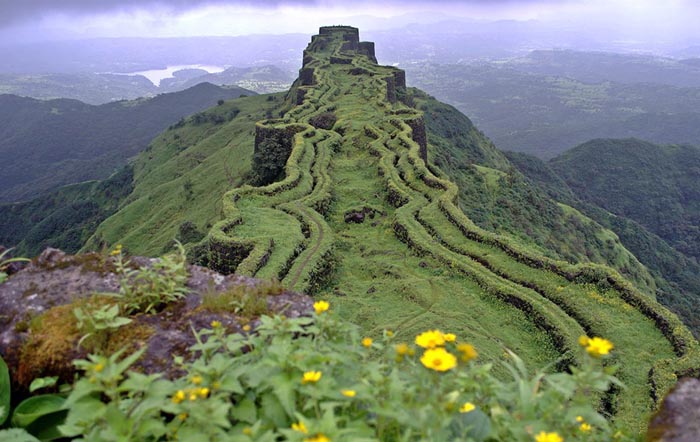Rajgad Fort

Information on Rajgad Fort (Pune, Maharashtra) - History & Architecture
Rajgad Fort is an ancient hill fort. It is a fortress which is unparallel with the rest of the forts found in Maharashtra. It is a great tourist spot and an adventure areas visited by lakhs of people every year. It is located at Pal Village, Pune District of Maharashtra in India.
Rajgad Fort Architecture
Rajgad Fort is built over a hill top plateau, having an altitude of 1318 meters height, in the Shyadri ranges. These are having a narrow stretch expanding in three sides with its central parts having larger areas. The central area is where the main fort complexes are built. This part is called the Balle Killa. Here one can find the main court yard and palaces. The main door of this fort is found here. There are lakes and few temples built here and were the important part of this fortification. The tree plateau stretches are well known as Sanjeeveni, Suvela and Padmavathi Machee. The Padmavathi Machee is found with small Padmavathi Temple, the wicket gate, a magazine room and the burial place of Queen Saibai. On its summit a manmade lake is built here and is known as the Padmavathi Lake. The Sanjeeveni Machee is the main bastion and has a narrow stretch with strong walls. It is in the west end were an emergency gate is built for soldiers to get down towards its slopes in the time of wars. The Suvela Machee is located in the south-east stretches. It has few doorways and hidden routs to go to the other parts of these fortification areas. This has an escape door to be used in emergence purpose. An Ambher Khana is built here for large storage purpose. It has got a strong Magazine room called the Darukhottar Ghar. Alongside the courtyard a Sardar Thana is found, which is place for his administrative officials. There are few hidden rooms built for safety purpose in time of war for the main members of the royal family. These are found mainly in the undergrounds of this fort. The fort exhibits truly a unique architectural marvel that is worth to praise.
Rajgad Fort History
Rajgad Fort is known in the Maratha history from 1490 AD when this area was with the regime of Nizam Shahi Sultan named Ahamed Bahiri. In 1630 AD the Bijapur King Adil Sha got control over this area and this fort in his control. In 1646 AD Shivaji fought with Adilsha and conquered this fort. He later on rebuilds this fort from the treasure he got from the neighboring fort. He commanded his Kingdom from here. This fort was captured by the Mughals of the North Delhi in 1703 AD. It was commanded by the Mughal Emperor Aurungzeb. Later on with the British rule it lost its importance. This fortress is also known as the royal fort of the Maharaja Shivaji in the initial years of becoming the Marath Wad King. He has stayed here for a longer period of time, estimated to be a 25-30 years of his life time. This fortress was his 1st Capital before shifting to Rajghad Fort. His queen named Saibai also lived here and gave birth to Rajaram Bhonsle, who was the younger son of the king. She stayed here in the queen's palace until her death and buried in this fort area. The sword slashed head of the Afzal Khan was buried near the Main gate of this fort in Bale Killa to mark his victory of Bijapur Kingdom. Locally this fort is called here as Murumdevi Killa and Rajghar. Murum Devi is a hill goddess temple located here.
Rajgad Fort Tourism Significance
Rajgad Fort is the King of Forts in the Marat Wad region or the present Maharashtra. This is a great place to see a magnificent stone made structure. This is a heritage site and an ancient monument well maintained by the tourism and archeological survey of India. While here one can see the past enjoying memorable time with dear ones. It would be worth to visit this for on weekends or on holidays and witness the timeless beauty the fort holds even after century old.
- Ahmednagar Monuments
- Akola Monuments
- Amravati Monuments
- Aurangabad Monuments
- Dhule Monuments
- Kolhapur Monuments
- Latur Monuments
- Mumbai Monuments
- Nagpur Monuments
- Nashik Monuments
- Palghar Monuments
- Pune Monuments
- Raigad Monuments
- Ratanagiri Monuments
- Satara Monuments
- Sindhudurg Monuments
- Thane Monuments
- Andaman Nicobar Monuments
- Andhra Pradesh Monuments
- Assam Monuments
- Bihar Monuments
- Chhattisgarh Monuments
- New Delhi Monuments
- Goa Monuments
- Gujarat Monuments
- Haryana Monuments
- Himachal Pradesh Monuments
- Jammu and Kashmir Monuments
- Karnataka Monuments
- Kerala Monuments
- Madhya Pradesh Monuments
- Maharashtra Monuments
- Odisha Monuments
- Punjab Monuments
- Rajasthan Monuments
- Tamil Nadu Monuments
- Telangana Monuments
- Uttar Pradesh Monuments
- West Bengal Monuments